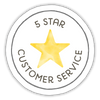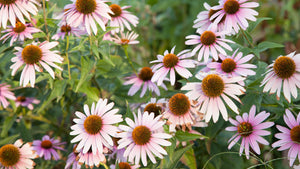Item Number: PV153
Organic Echinacea Angustifolia
Organic Echinacea Angustifolia
Flourish in Herbal Abundance
Echinacea Augustifolia, commonly known as narrow-leaved coneflower or black samson, is a herbaceous perennial plant native to North America. Belonging to the Asteraceae family, this medicinal herb has long been used by Indigenous peoples for its reputed health benefits. Echinacea Augustifolia is prized for its striking purple flowers and robust growth habit, making it a popular choice for home gardens and herbal medicine enthusiasts.
Sustainably grown in 2.75" pots
Choosing the Right Location
When growing Echinacea Augustifolia, selecting the right location is crucial for its success. This perennial herb thrives in full sun to partial shade, preferring well-drained soil with a neutral to slightly acidic pH level. Choose a site with good air circulation to prevent the development of fungal diseases, and avoid planting in low-lying areas prone to waterlogging. Echinacea Augustifolia can tolerate a wide range of soil types, including sandy, loamy, or clay soils, but it performs best in fertile, moisture-retentive soil.
Planting Echinacea Augustifolia
Plant Echinacea Augustifolia in early spring or fall, spacing individual plants 18 to 24 inches apart to allow for proper growth and airflow. Dig a hole slightly larger than the root ball, and gently firm the soil around the plant.
Watering and Care
Echinacea Augustifolia has moderate water needs and prefers consistent moisture throughout the growing season. Water newly planted seedlings regularly to establish strong roots, then transition to deep, infrequent watering once the plants are established. Avoid overwatering, as this can lead to root rot and other problems. Mulching around the base of the plants can help retain soil moisture and suppress weeds. Echinacea Augustifolia is relatively low-maintenance once established but benefits from regular deadheading to prolong blooming and prevent self-seeding.
Fertilizing
Echinacea Augustifolia is not a heavy feeder and generally does not require fertilization if planted in nutrient-rich soil. However, you can apply a balanced fertilizer or compost in early spring to provide additional nutrients if needed. Be cautious not to over-fertilize, as excessive nitrogen can result in lush foliage at the expense of flowering. Monitor the growth of your Echinacea Augustifolia plants and adjust fertilization accordingly based on their performance.
Pruning and Maintenance
Echinacea Augustifolia is a relatively low-maintenance plant but benefits from occasional pruning to remove spent flowers and encourage bushier growth. Deadheading faded blooms promote continuous flowering and prevent the plant from diverting energy into seed production. In late fall or early spring, cut back the stems to ground level to tidy up the plant and promote vigorous regrowth in the coming season. Divide overcrowded clumps every few years to rejuvenate older plants and maintain their vigor.
Pest and Disease Management
Echinacea Augustifolia is generally resistant to pests and diseases, but it may occasionally be affected by aphids, powdery mildew, or aster yellows disease. Monitor your plants regularly for signs of pest infestations or disease symptoms, and take appropriate action to control them. Remove and destroy any affected plant parts, and consider using organic pesticides or fungicides as needed to protect your Echinacea Augustifolia crop.
Overwintering
Echinacea Augustifolia is a hardy perennial that can withstand winter temperatures with proper protection. In regions with cold winters, mulch around the base of the plants in late fall to insulate the roots and protect them from freezing temperatures. Alternatively, you can grow Echinacea Augustifolia in containers and overwinter them indoors in a cool, bright location until spring. With proper care and maintenance, Echinacea Augustifolia can thrive for many years in your garden.
Growing Echinacea Augustifolia can be a rewarding experience, offering beautiful blooms and potential health benefits for you and your garden. By following the guidelines outlined in this guide and providing proper care and attention, you can cultivate healthy Echinacea Augustifolia plants that will enhance your landscape and provide herbal remedies for years to come. Whether used for its medicinal properties or ornamental value, Echinacea Augustifolia is a versatile and valuable addition to any garden.





Check Your Zone Compatibility:
Compatible with your zone.
Growing Zone for
,

Our Guarantee To You
Since 1976, we've served our customers at every stage of growing. Please contact us at any time. We are happy to support and assist you.
Description
Description
Echinacea Augustifolia, commonly known as narrow-leaved coneflower or black samson, is a herbaceous perennial plant native to North America. Belonging to the Asteraceae family, this medicinal herb has long been used by Indigenous peoples for its reputed health benefits. Echinacea Augustifolia is prized for its striking purple flowers and robust growth habit, making it a popular choice for home gardens and herbal medicine enthusiasts.
Sustainably grown in 2.75" pots
Choosing the Right Location
When growing Echinacea Augustifolia, selecting the right location is crucial for its success. This perennial herb thrives in full sun to partial shade, preferring well-drained soil with a neutral to slightly acidic pH level. Choose a site with good air circulation to prevent the development of fungal diseases, and avoid planting in low-lying areas prone to waterlogging. Echinacea Augustifolia can tolerate a wide range of soil types, including sandy, loamy, or clay soils, but it performs best in fertile, moisture-retentive soil.
Planting Echinacea Augustifolia
Plant Echinacea Augustifolia in early spring or fall, spacing individual plants 18 to 24 inches apart to allow for proper growth and airflow. Dig a hole slightly larger than the root ball, and gently firm the soil around the plant.
Watering and Care
Echinacea Augustifolia has moderate water needs and prefers consistent moisture throughout the growing season. Water newly planted seedlings regularly to establish strong roots, then transition to deep, infrequent watering once the plants are established. Avoid overwatering, as this can lead to root rot and other problems. Mulching around the base of the plants can help retain soil moisture and suppress weeds. Echinacea Augustifolia is relatively low-maintenance once established but benefits from regular deadheading to prolong blooming and prevent self-seeding.
Fertilizing
Echinacea Augustifolia is not a heavy feeder and generally does not require fertilization if planted in nutrient-rich soil. However, you can apply a balanced fertilizer or compost in early spring to provide additional nutrients if needed. Be cautious not to over-fertilize, as excessive nitrogen can result in lush foliage at the expense of flowering. Monitor the growth of your Echinacea Augustifolia plants and adjust fertilization accordingly based on their performance.
Pruning and Maintenance
Echinacea Augustifolia is a relatively low-maintenance plant but benefits from occasional pruning to remove spent flowers and encourage bushier growth. Deadheading faded blooms promote continuous flowering and prevent the plant from diverting energy into seed production. In late fall or early spring, cut back the stems to ground level to tidy up the plant and promote vigorous regrowth in the coming season. Divide overcrowded clumps every few years to rejuvenate older plants and maintain their vigor.
Pest and Disease Management
Echinacea Augustifolia is generally resistant to pests and diseases, but it may occasionally be affected by aphids, powdery mildew, or aster yellows disease. Monitor your plants regularly for signs of pest infestations or disease symptoms, and take appropriate action to control them. Remove and destroy any affected plant parts, and consider using organic pesticides or fungicides as needed to protect your Echinacea Augustifolia crop.
Overwintering
Echinacea Augustifolia is a hardy perennial that can withstand winter temperatures with proper protection. In regions with cold winters, mulch around the base of the plants in late fall to insulate the roots and protect them from freezing temperatures. Alternatively, you can grow Echinacea Augustifolia in containers and overwinter them indoors in a cool, bright location until spring. With proper care and maintenance, Echinacea Augustifolia can thrive for many years in your garden.
Growing Echinacea Augustifolia can be a rewarding experience, offering beautiful blooms and potential health benefits for you and your garden. By following the guidelines outlined in this guide and providing proper care and attention, you can cultivate healthy Echinacea Augustifolia plants that will enhance your landscape and provide herbal remedies for years to come. Whether used for its medicinal properties or ornamental value, Echinacea Augustifolia is a versatile and valuable addition to any garden.
Shipping Information
Shipping Information
Cannot ship to the following states: AK, HI, PR, VI, GU
Shipping Weight: 0.5 lb
Dimensions: 6.0"L x 2.75"W x 2.75"H
Features
Features
- Attracts Bees/Butterflies
- Good Cut Flower
- Open-Pollinated
- Wildflower
Characteristics
Characteristics
Planting & Care
Planting & Care
Soil & Water: Grow in well-drained soil with average fertility.
Planting & Growing: Plant starts in late spring or early summer, once the soil has warmed up to at least 60°F (21°C). Space plants 2 feet apart.
Harvesting & Storage: Cut when petals are just starting to expand for flowers. For cone harvest, cut when the cone has turned golden. You can harvest the roots after the third season.
Useful Information
Useful Information
Guarantee
Guarantee
We guarantee the perishable items we sell to be in good, viable condition when we sell them. Perishable items include, but are not limited to, garlic bulbs, flower bulbs, seed potatoes, onion sets & transplants, potted or bare root trees, vegetable crowns, etc. If your perishable item arrives in substandard condition, take photographs and please contact us within 3 days of the purchase date (or delivery date) and we will provide you with a refund of the purchase price (excluding shipping costs), or a replacement. Accordingly, we urge you to open any boxes marked as ""Perishable"" immediately upon receiving them and inspect the shipment thoroughly (do not crack open heads of garlic, we do not accept claims on cracked garlic). Because some perishable items can deteriorate very quickly, we cannot accept any claims beyond the 3-day time frame as it becomes too difficult to determine if these items were delivered in substandard condition, or if they turned into such substandard condition because of having been improperly cared for or stored once delivered.
Share



